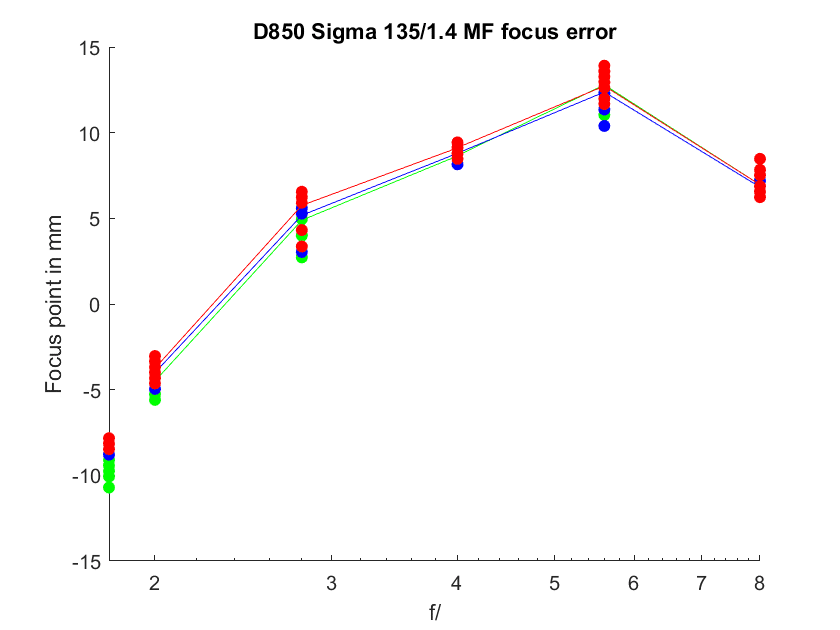This is a continuation of a series of posts on the Nikon D850. The series starts here. You should be able to find all the posts about that camera in the Category List on the right sidebar, below the Articles widget. There’s a drop-down menu there that you can use to get to all the posts in this series; just look for “D850”.
In a previous post, I reported on my progress in developing a software tool to process image sets made of a LensAlign target to produce the sort of results that FocusTune does: focus distance versus AF Adjust setting. Yesterday, I applied that technique to the Nikon 105/1.4 on a D850, with a subject distance of ten feet. Earlier today, I did the same thing with the excellent Sigma 85 mm f/1.4 Art lens. Now I’m turning my attention to the Sigma 135 mm f/1.8.
Target distance was 13.5 feet. I’m standardizing on target distances in feet equal to lens focal length in centimeters. I focussed manually at the beginning of the series and making 10 images at the whole-stops from f/1.8 through f/8. Here’s the result for the AdobeRGB green channel:
First off, the title is wrong, as are all the titles on the graphs on this page. The Sigma 135 is not an f/1.4 lens. Mea culpa. All image points are plotted, 10 for each f-stop. Back-focusing is indicated by positive y-axis numbers and front-focusing by negative ones. I focused the first image with CDAF wide open, and got a small amount of front focusing, but I’m not totally confident in the location of the target plane right now, so don’t put much stock in that. The green line is the average for each stop, and I only calculated it for the whole stops. As you can see, the spread in the data for each stop is quite small, and we don’t really need the average line. The forward movement in the subject focal plane at f/8 may be an error; the technique that I’m using becomes less accurate as the DOF increases.
You can also see about 2 cm of focus shift as the lens is stopped down, which I’ve observed using other analysis methods.
All three AdobeRGB channels:
The amount of back-focusing of the red channel with respect to the green is very low. This lens has excellent longitudinal chromatic aberration (LoCA).
When I use the D850’s contrast-detection autofocus (CDAF) on every shot in a similar series, here is what the green channel data looks like:
There’s a fair amount of scattering, but there’s not much systematic variation with f-stop.
All channels:
With a lens with as little LoCA as this one, the all-channel graphs doesn’t add much.
Using the D850’s PDAF autofocusing:
The graph shows some of the same focus shift behavior that we saw with manual focusing, but not at f/2. I have no idea what that’s about.
All channels:






Christoph Breitkopf says
Jim, there seems to be some wishful thinking in the graph titles 😉
JimK says
Oops. I see now. Thanks. Maybe I’ll fix it, but for now, I’m going to add a disclaimer.
Livio Spallone says
Hi Jim
This last graph , about PDAF, surprised me.
More than the f2.8 value it is the low scattering of the focus plane making PDAF much better than CDAF in this case.
Could be that some lenses are less CDAF friendly?
My bests
Livio